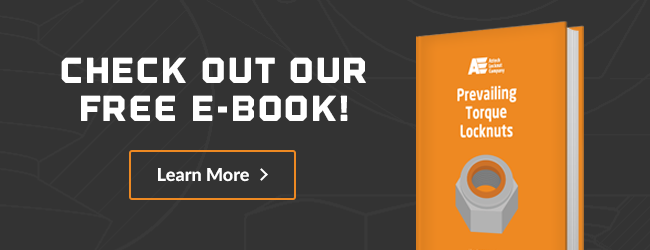
Within the locknut category, there are two sub-categories of nuts: prevailing torque locknuts and tension-induced locknuts. Both of these nuts can be removed; they are not permanently locked into place.
Both types of locknuts have the locking feature implied in their names, yet this feature is accomplished very differently between the two nuts.
Prevailing Torque Locknuts
Prevailing torque locknuts require a considerable amount of torque to both tighten and loosen the nut, regardless of a lack of tension in the mating bolt or stud. They must be wrenched in order to be fully tightened or loosened.
The reason for the required increase in torque is a unique feature within the nut that creates a large frictional interference between threads. For this reason, loosening or removing the nut can permanently damage the locking mechanism.
Prevailing torque locknuts do begin to lock as soon as they are used, so it is not recommended to use them on long threaded assemblies. This could damage the locking feature of the nut.
Tension-Induced Locknuts
Tension-induced locknuts, otherwise known as free-spinning locknuts, do not begin to lock until they are firmly seated against a base. Once they are at this point, the nut must be tightened further to achieve the locking action.
Tension-induced nuts are held into place by increased friction from the spring of the wedging action of tightening the nut. The grip on the bolt threads gets tighter and tighter, to keep the nut from loosening.
Unlike prevailing torque locknuts, tension-induced nuts are perfect for long threaded assemblies. The free-spinning nut will not lock into place until sufficient pressure is achieved.
Choosing the Right Locknut
Choosing between a prevailing torque locknut and a tension-induced locknut will mainly depend on the application. Prevailing torque locknuts are excellent for shorter assemblies that need the immediate resistance to loosening that this nut provides. They also can be used with fragile components. Tension-induced nuts on the other hand should only be used with durable components. They can, however, be used on longer assemblies due to their free-spinning nature.
For more information about choosing a locknut that will suit your application, consider our FREE guide to choosing prevailing torque locknuts entitled, “Prevailing Torque Locknuts: Understanding Specifications Documents.”
Sources:
http://machinedesign.com/basics-design/free-spinning-nuts
http://www.fastenermart.com/flange-nuts.html



